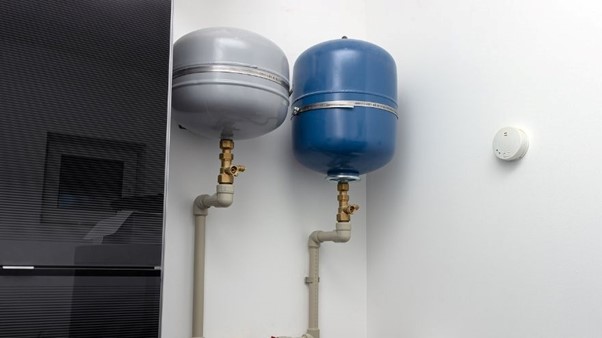The expansion vessel is one of the basic elements of the central heating and hot water installations, whose task is to protect the system against the destructive effects of increases in water pressure. There are two main types of devices of this type on the market - open and diaphragm. In our guide, we will characterize them both and tell you what to consider when choosing them.

From this article you will learn:
- What is the difference between surface-mounted and flush-mounted faucets?
- What to pay attention to when choosing a concealed and surface-mounted faucet,
- Which type of bathroom faucets to choose.
Diaphragm expansion vessels - what should you consider when choosing?
The expansion vessel is intended to absorb excess water resulting from its heating in the system. The liquid whose volume increases is stored in a special tank. After reducing the system temperature, it returns to circulation. As you can see, the expansion vessel serves to protect the central heating and hot water installations. Without it, the increase in pressure could lead to bursting of pipes and damage to the entire system.
Check out the diaphragm expansion vessels from Reflex
To effectively protect the central heating or hot water installation, you must select the appropriate expansion vessel for the given system. Investors will find two types of devices on the market:
- Open expansion vessel – installed at the highest point in the water circuit and absorbing its excess in order to maintain constant pressure in the installation. The tank works with solid fuel boilers and is directly connected to the heating device with a vertical riser pipe.
- Diaphragm expansion vessels – equipped with two separate chambers: water and gas. Any increase in water volume compresses the air, which prevents the pressure from increasing. This type of devices is used in closed installations, i.e. with gas or oil boilers. An expansion vessel is also the most common choice for domestic hot water systems.
First, the type of expansion vessel should be matched to the specific type of installation. When selecting a tank for a central heating system with a solid fuel boiler, look for open variants. However, if you need an expansion vessel for a closed heating installation or hot water system, choose a diaphragm device.
Check out the diaphragm expansion vessels from Reflex
Only when you find out which type of expansion vessel suits your installation can you start considering the specific parameters of the tank. They must meet the system specifications. So take the following criteria into account:
- initial pressure,
- water volume increase,
- density of water at rest temperature,
- total water volume in the installation.
Of course, these are not the only factors influencing the selection of the appropriate expansion vessel. It is also worth paying attention to the quality of the device and the components used in its production. For example, a replaceable rubber membrane will be important, as it guarantees the purity of water in the hot water installation. In such a system, it is also impossible to ignore the initial pressure of the expansion vessel.
The expansion vessel installed in the hot water system should have an initial pressure of at least 3.5 bar. Slightly lower values are recommended for solar systems (min. 2.5 bar) and central heating systems (min. 1.5 bar). While selecting this parameter seems quite simple, it is much more difficult to adjust the capacity of the expansion vessel to a specific installation. We explain the rules regarding this criterion in the paragraph below.

What size should the expansion vessel be?
It is assumed that the water in the installation can increase its volume by a maximum of 4%. And this is the size of the expansion vessel. However, it is worth remembering that water filling the pipes reaches the contents of the tank. It is therefore recommended that the volume of the expansion tank be approximately 5% of the total capacity of the installation.
Note that in this case it is not about the total capacity of the vessel, but about the usable capacity, i.e. the volume of the water chamber alone. This information is sometimes difficult to find on the device's nameplate. For simplicity, you can assume that the value you are interested in is at least 1/3 smaller than the total capacity provided by the manufacturer.
It is always safer to choose a dish that is a little too big than too small. It will guarantee you a certain volume reserve - for example in the event of a pressure drop in the gas part of the tank. Remember that not only the expansion vessel must be adapted to the installation capacity, but also the open one. In both cases, the calculation procedure itself, which allows determining the volume of the system, may turn out to be quite problematic. Therefore, it is worth using practical online tools that take into account all key parameters, such as the volume of the heating installation, water density, increase in its volume and initial pressure).
Exchange benefits in the new OnnTop loyalty platform!
Expansion vessels in the Onninen offer
When working on central heating or hot water installations, do not hesitate to recommend Reflex products to your customers. This is a company specializing in expansion pressure vessels that guarantee the safety and comfort of operation of both heating and water systems.
Our online wholesale store offers a wide range of Reflex brand products, including various types of diaphragm expansion vessels. Among them you will find, for example:
- DE-33 expansion vessel for domestic hot water - used in fire protection and utility water installations, but also in underfloor heating. It is not equipped with flow, cut-off or draining fittings, but all its parts in contact with water are protected against corrosion. The replaceable membrane is also certified by the National Institute of Hygiene. The model we present is characterized by a final pressure of 10 bar, a maximum medium temperature of 70 degrees Celsius and a capacity of 33 liters.
- N-140 expansion pressure vessel – used to protect heating and cooling systems. It is equipped with an R1" threaded connection and a non-replaceable membrane. The permissible operating pressure of the tank is 6 bar and the maximum water temperature is 120 degrees Celsius. The device is installed in a standing position.
- S25 diaphragm pressure vessel – used in closed solar, heating and cooling systems. It is equipped with antifreeze, a threaded connection and a non-replaceable membrane. It has a maximum operating pressure of 10 bar and is available in many sizes with capacities from 2 to 600 liters. The device is mounted in a hanging position.
- Diaphragm expansion vessel N-8 – used in heating and cooling systems. It has an R3/4" threaded connection and a non-replaceable membrane. The tank has a hanging mounting, permissible operating pressure of 4 bar and maximum system temperature of 120 degrees Celsius.
A wide range of Reflex products will allow you to correctly select the expansion vessel to suit the specificity of a given installation. Check out our wholesale offer and get reliable expansion tanks!